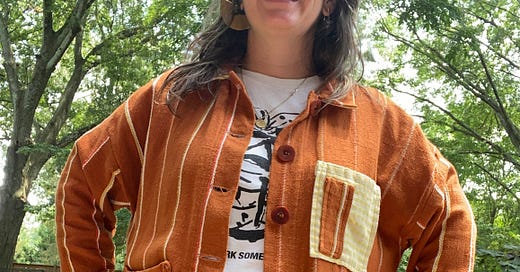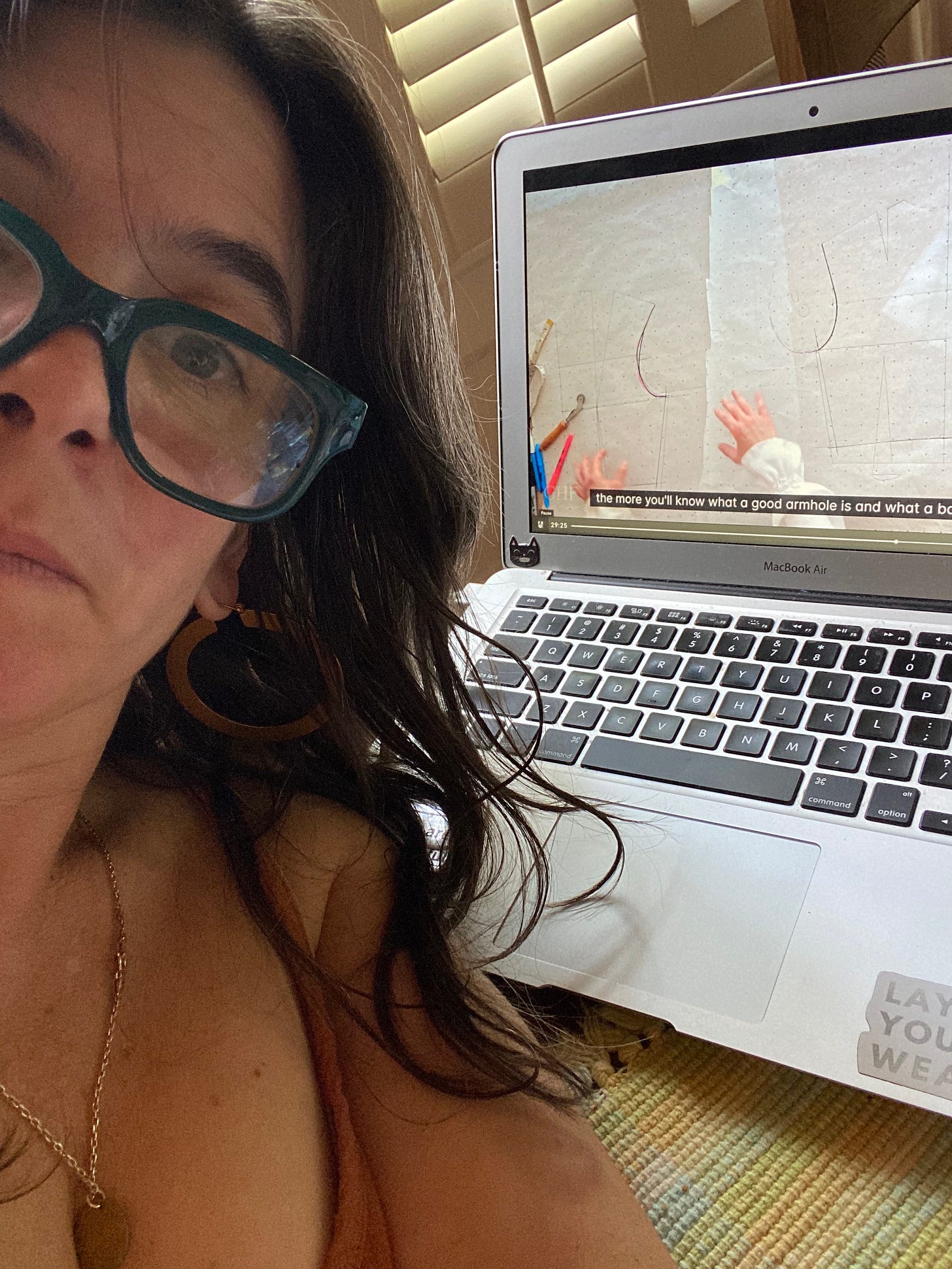I’m taking a break from the series I’ve been writing lately about my work as a white antiracist facilitator to announce something new and exciting.
I’M TEACHING A SEWING CLASS!
For anyone who is interested in learning how to sew garments but is intimidated by how to get started, how to read patterns, how to choose fabric, how to recover from mistakes, how to get all the way to a finished garment, this is for you!
If you know a bit but not a lot about sewing, have a sewing machine accessible, and want to try this out, I would be excited to sew with you.
All the details are on my website, here.

Why do I love sewing garments? What are some of the ways it benefits me? What are some of my hypotheses about how this practice can be liberatory?
Every body is unique. It’s affirming to make and wear garments that fit my body’s current shape rather than be at the mercy of pant legs and sleeves that are always too long, as just one example. Choosing clothes from a measuring system that’s based on patriarchal, colonial, and ableist notions of how bodies should be shaped, or rather the shapes clothing should be that we then must contort ourselves to feel ok in, is not necessary. What if we started instead from the truth that each body is acceptable as it is, and that each person deserves clothes that fit well and make that person feel good?
Color and texture bring me delight. The pairing of fabrics and garment shapes available in stores and online often bores or repels me. The range of fabrics available for sewists is great fun to explore. Making a garment from a fabric I love is delightful to touch, to look at and to wear. What if we got to wear fabrics that made us feel more delight? What if we expressed ourselves more creatively and authentically through clothing, less constrained by what the fashion industry has deemed trendy or sellable on a massive scale? And by what the fashion industry has deemed acceptable for people who are supposed to fit into false and constraining definitions of gender?
The experience from start to finish is empowering and satisfying. Starting with a flat, rectangular piece of cloth, cutting it into flat shapes, and then slowly watching these pieces become a three-dimensional garment is magical. I’m never able to completely picture what the completed garment will look like when I begin. With each step, I think “oh, that’s how to make it do that!” So many other things I’m working on aren’t finishable in my lifetime (e.g., ending white supremacy), but garments can be completed. Why not enjoy the feeling of completing something, knowing all it took to make it, and then wearing it with pride?
I learn a lot from making mistakes. I get to practice taking my mistakes less seriously, and even delighting in unexpectedly wonderful things that happen as a result. Maybe I cut a piece of fabric out upside down, and end up with the left front of a shirt with stripes going horizontal instead of vertical; and that actually made the garment much more interesting. Maybe I ran out of fabric before cutting all my pieces, and then chose a contrasting fabric for a part of the collar or sleeve cuff; and that actually made the garment more fun. I like the feeling of wearing garments I made, knowing their imperfections, and enjoying the ways the final product surprised me.
Sewing connects me with an art, a craft, and a labor with tendrils across space and time. Living in the US in 2025, I am disconnected from the invisible and exploited labor of most of the people who make the clothing I can buy. The ways clothes have been designed, made and worn throughout human history and in different parts of the world illuminate worldviews about the body and adornment, information about folk traditions and magical symbols, examples of power and subversion, impacts of colonialism and enslavement, histories of reproductive labor, and so much more. Each fiber, from cotton to wool to rayon, has stories to tell. My craft includes not just garment sewing but quilting and embroidery as well. In my early 20s I was into weaving and yarn spinning. I’ve done quite a bit of knitting and cross-stitch over the years too. When it comes to needle and thread and fabric, I’m interested in the ways these can connect us through space and time to ways of knowing and being outside of dominant culture - before and after the era of white supremacy - and in what the medium itself has to teach us about how we might move through the polycrises of this time with more purposeful and impactful choices.
Two of the garment sewists I’ve been inspired by most consistently over recent years are Meg McElwee of Sew Liberated and Jasika Nicole. I trust their values, approach, and creativity. I recommend checking them and their work out!
The first questions I will ask of you, if you come to sewing school with me, are: What do you want to cloak yourself in during this next season? What feeling do you want this garment to evoke for you when you wear it? How might this garment support you to be who you want to be now—whether at home or out and about?
Whatever that feeling is, I will encourage you to evoke this energy with the fabric you select, and with the ways you style your jacket. Let this sewing project be purposeful and delightful. Let it support you in ways you don’t expect.
For those who sign up for sewing school with me, the practical guidance you’ll receive includes:
the steps of garment sewing broken down into a clear process, from start to finish
accompaniment - wherever you get frustrated or stuck or confused, you won’t be alone
how to use a sewing pattern - demystify what can be the most intimidating obstacle to sewing garments
how to select a fabric - with pro tips, and in alignment with how you’ve answered the questions above :)
how to make fit adjustments to the pattern, based on your body shape and size
Here’s a 3-D tour of my Ilford Jacket, for those interested in signing up for sewing class:
Feel free to share this with anyone else you think might be interested! All you need to participate is access to a sewing machine, basic knowledge about how to thread and work the machine, and internet access. I’ll walk you through all the rest.




